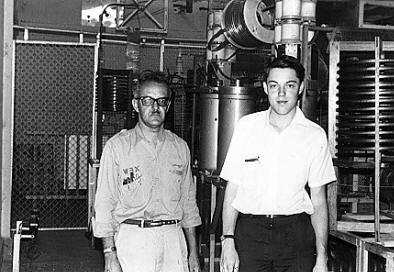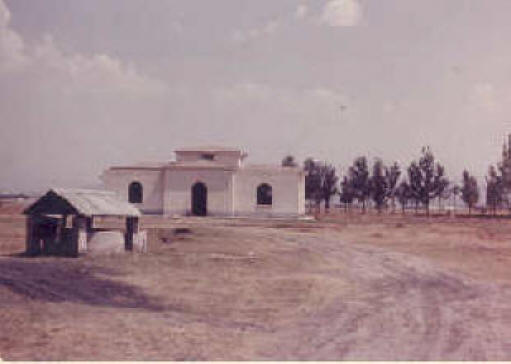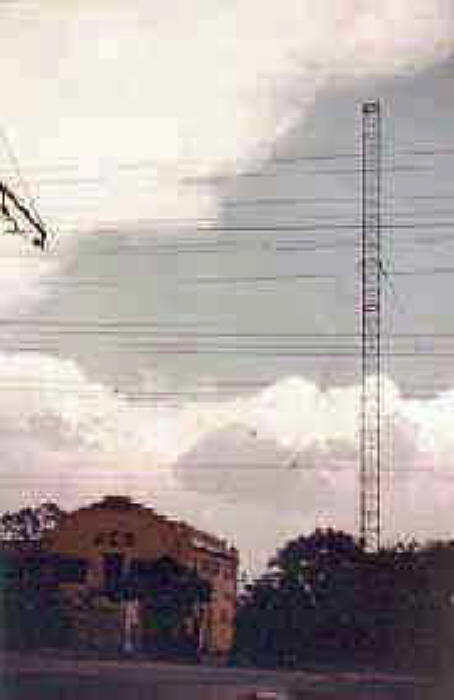| |
 |
|
|
México 1963
I took these pictures while living in Mexico City in
1963
during which time I was an intern at
Organización Radio Centro |
 |
|

 |
XEB - "La
Voz de la América Latina desde México"
This 250,000 giant
was the major force in communications in Mexico for decades, and
its owners created Televisa. In addition to AM, the station
broadcast on Short-wave and had relay transmitters in San Luis,
Guadalajara, Veracruz and Monterrey.
"La W" had a
massive 1/2 wave tower.
|
 |
Inside the final stage one of the massive 250,000
watt transmitters
with the transmitter engineer for XEW. |
 |
|
Two of the three
250 kw transmitters.
|
 |
Antenna switch ...to enable
alternating the 250 kw transmitters every 2 hours.
Transmitter
change was done manually, including the changes of the switch. |
 |
 |
|
Here is the XEW studio location at Ayuntamiento 54 in recent years
from Google. All that has changed is the sign on the marquee. |
And here is the renowned xylophone with which XEW identified itself
along with the phrase, "XEW, La Voz de la América Latina desde
México." |
 |
The Núcleo Radio Mil building on Insurgentes
Sur Housed Radio 590,
Radio Mil, Radio Eco and Radio Onda 1530. |
 |
Artículo 123 #90
was a famous address for decades...
..as it was the home of Organización Radio Centro and its 5 AM stations,
XERC-790, XEQR-1030, XEJP-1150, XEAI-1320 and XELZ-1440.
Consolidation was a normal fact of life in much of Latin America
since the 1950's... with Mexico City having several
multi-station groups.
|
 |
|
A ORC studio...
this for XELZ
Radio LZ had a
top-40 Ranchera format, and the diagonal sign on the window says
"SPEED," while the other sign reminds the DJ to give the station
name every time the mike opens! |
 |
|
XENK "Radio
6-20""Studio on Balderas Street in downtown Mexico City.
This station was
famous for its format based on English language MOR music and
its phrase,
"La Música que Llegó para Quedarse |
 |
|
XENK transmitter
near Lake Texcoco. |
 |
|
XEX at the Radiópolis building
on Dr. Río de La Loza
This location was just across the street
from the Televisa studios,
which were totally destroyed in the
1985 earthquake. |
 |
|
The Radiópolis building housed
XERPM, XEX, XEB, XEDF and XEMP, "La Chaparrita del Cuadrante"
(710 AM) |
 |
Few listeners today can recognize the
the distinctive 3-note chimes of XEB,
La B Grande de México XEB was the first licensed station in
Mexico City
and was known as "El Buen Tono.
|
 |
|
The XEQ 940 AM transmitter site, also near
Lake Texcoco, 50 kw. |
 |
|
XEX transmitter building, yet another of the many transmitter sites
near Lake Texcoco. |
 |
|
XEX announcer. |
 |
|
100 kw XEB transmitter |
 |
XEB transmitter building and tower. 100 kw on 1220.
This station has
many memories for me, as I listened as a teenager and would
frequently call in to the overnight show to make musical
requests, mostly for my favorites, the Sonora Santanera. |

|
 |
Final (RF)
tube of the home-built XEB transmitter.
Throughout Latin
America, locally built transmitters prevailed in the 60's. They
were less expensive, and used locally obtainable parts. Since
there was no "type acceptance" rule, it was usually just a
matter of submitting a schematic for approval and then building
the transmitter. From 1964 to 1970, I put nearly two dozen
transmitters on the air in Ecuador... every one of which was
built in-house!
|
Cooling Tower for the 100 kw XEB
Transmitter.
Note the bottles
of distilled water sitting on the ground. Although it looks
unsophisticated, it was very functional. In fact, the entire
transmitter was locally designed and built and covered the
better part of North America at night! |

 |
The majority
of the High power...
Mexican AM stations used shunt-fed antennas,
tuned by locating the match point for the open feed
line at a point up the tower.
|
The base of the XEB tower.
Note the lack of an insulator on this shunt feed
tower. |
 |
|
Tower of XEFR, Radio Felicidad on 1180 with 1 kw. |
 |
|
XEMC 1590 AM and XESC shortwave. |
 |
|
On the air at XEMC |
 |
|
The real XEMC announcer. |
 |
|
The inactive XESC
short-wave transmitter.
|
 |
XEQK did nothing but announce the time every
minute and then run 11 little
5-second spots! Here is the clock (synchronized with the National
Observatory) device which triggered the time tones and controlled
the automation system!
|